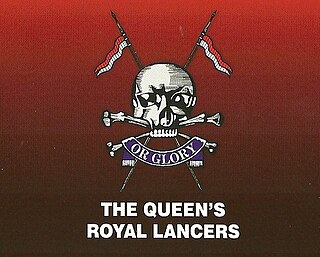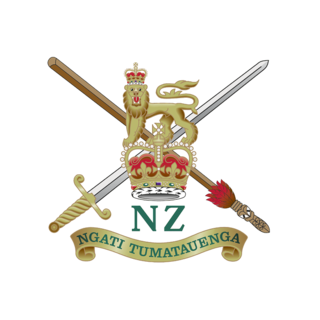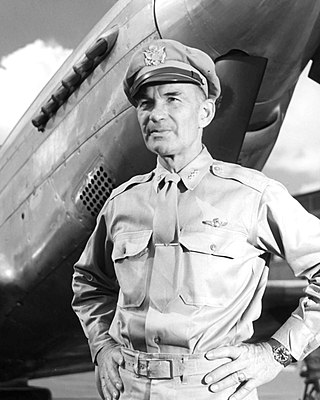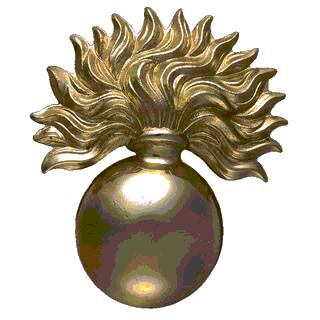
The Coldstream Guards is the oldest continuously serving regular regiment in the British Army. As part of the Household Division, one of its principal roles is the protection of the monarchy; due to this, it often participates in state ceremonial occasions. The Regiment has consistently provided formations on deployments around the world and has fought in the majority of the major conflicts in which the British Army has been engaged.

The Cheshire Regiment was a line infantry regiment of the British Army, part of the Prince of Wales' Division. The 22nd Regiment of Foot was raised by the Duke of Norfolk in 1689 and was able to boast an independent existence of over 300 years. The regiment was expanded in 1881 as part of the Childers Reforms by the linking of the 22nd (Cheshire) Regiment of Foot and the militia and rifle volunteers of Cheshire. The title 22nd (Cheshire) Regiment continued to be used within the regiment.

The Queen's Royal Lancers (QRL) was a cavalry regiment of the British Army. It was formed in 1993 and amalgamated with the 9th/12th Royal Lancers on 2 May 2015 to form the Royal Lancers.
The Defence Intelligence Division of the South African National Defence Force is the primary military intelligence agency of South Africa which came into being on 27 April 1994. The other intelligence agencies of the country are:

The Zimbabwe National Army (ZNA) is the primary branch of the Zimbabwe Defence Forces responsible for land-oriented military operations. It is the largest service branch under the Zimbabwean Joint Operations Command (JOC). The modern army has its roots in the Rhodesian Army, which was raised between 1963 and 1964 after the breakup of the Federation of Rhodesia and Nyasaland. A Joint High Command created in March 1980 to oversee integration of the formerly belligerent Rhodesian Security Forces, Zimbabwe African National Liberation Army (ZANLA), and the Zimbabwe People's Revolutionary Army (ZIPRA) officially established the Zimbabwe National Army in late 1980, nearly a year after the end of the Rhodesian Bush War.

The Royal New Zealand Army Medical Corps (RNZAMC) is a corps of the New Zealand Army, the land branch of the New Zealand Defence Force (NZDF). The Medical Corps provides for the medical needs of soldiers, such as diagnosing and treating diseases and injuries. Medical personnel are part of almost all Army exercises and operations, and personnel work in conjunction with personnel from the Royal New Zealand Dental Corps and the Royal New Zealand Nursing Corps.
The 1st North Carolina Regiment of the Continental Army was raised on September 1, 1775, at Wilmington, North Carolina. In January 1776 the organization contained eight companies. Francis Nash was appointed colonel in April 1776. The regiment was present at the defense of Charleston in 1776. It transferred from the Southern Department to George Washington's main army in February 1777. At that time, Thomas Clark became colonel of the 1st Regiment. The regiment became part of General Francis Nash's North Carolina Brigade in July.

The General Dan Pienaar Artillery Regiment is a reserve artillery regiment of the South African Army.

The Essex Yeomanry was a Reserve unit of the British Army that originated in 1797 as local Yeomanry Cavalry Troops in Essex. Reformed after the experience gained in the Second Boer War, it saw active service as cavalry in World War I and as artillery in World War II. Its lineage is maintained by 36 Signal Squadron, part of 71 (Yeomanry) Signal Regiment, Royal Corps of Signals.

The Scots Guards (SG) is one of the five Foot Guards regiments of the British Army. Its origins are as the personal bodyguard of King Charles I of England and Scotland. Its lineage can be traced back to 1642, although it was only placed on the English Establishment in 1686.
The Malaya Command was a formation of the British Army formed in the 1920s for the coordination of the defences of British Malaya, which comprised the Straits Settlements, the Federated Malay States and the Unfederated Malay States. It consisted mainly of small garrison forces in Kuala Lumpur, Penang, Taiping, Seremban and Singapore.

The 3rd Dragoon Guards was a cavalry regiment in the British Army, first raised in 1685 as the Earl of Plymouth's Regiment of Horse. It was renamed as the 3rd Regiment of Dragoon Guards in 1751 and the 3rd Dragoon Guards in 1765. It saw service for two centuries, including the First World War, before being amalgamated into the 3rd/6th Dragoon Guards in 1922.

Millard Fillmore Harmon Jr. was a lieutenant general in the United States Army Air Forces during the Pacific campaign in World War II. He was presumed to have perished in February 1945 on a flight when the plane carrying him disappeared in transit. Harmon, Frank Maxwell Andrews, Simon Bolivar Buckner Jr. and Lesley J. McNair, all lieutenant generals at the time of their deaths, were among the highest-ranking Americans to die in World War II.

The Grenadier Guards is an infantry regiment of the British Army. It can trace its lineage back to 1656 when Lord Wentworth's Regiment was raised in Bruges to protect the exiled Charles II. In 1665, this regiment was combined with John Russell's Regiment of Guards to form the current regiment, known as the 1st Regiment of Foot Guards. Since then, the regiment has filled both a ceremonial and protective role as well as an operational one. In 1900, the regiment provided a cadre of personnel to form the Irish Guards; while later, in 1915 it also provided the basis of the Welsh Guards upon their formation.

The Officers Training Academy (OTA) is a training establishment of the Indian Army that trains officers for the Short Service Commission (SSC). The 49-week course at the OTA prepares graduates for all branches of the Army, except for the Army Medical Corps. Established in 1963, the first academy is located in Alandur, a southern neighbourhood of Chennai. OTA chennai has an impressive tally of gallantry award including 1 Param Vir Chakra, 8 Ashoka Chakra, 10 Maha Vir Chakra, 22 Kirti Chakra, 63 Vir Chakra, 119 Shaurya Chakra and 587 Sena Medal earned by the officers commissioned from this academy bears testimony to the Valor and dedication displayed by the Alumni. A new academy was set up at Gaya in 2011; but was given the go-ahead in December 2019 to be disbanded.

75th Division was an infantry division of the British Army in World War I. It was raised in the field by the Egyptian Expeditionary Force (EEF) in 1917 and it included British, Indian and South African troops. It served in the Middle East during the Sinai and Palestine Campaign being involved in the Battles of Megiddo.

The Namibian Army is the ground warfare branch of the Namibian Defence Force.
Major General Les Rudman was a General Officer in the South African Army from the infantry.

Midmar Commando was a light infantry regiment of the South African Army. It formed part of the South African Army Infantry Formation as well as the South African Territorial Reserve.
Brig. Gen. Khaya Makina was a General Officer in the South African Army from the artillery. He was born in New Brighton location in Port Elizabeth on 6 June 1964. He matriculated from Khwezi Lomso High School in 1982. He joined the uMkhonto we Sizwe and went into exile in the Kingdom of Lesotho and later in the Republic of Angola where he completed military training.
















